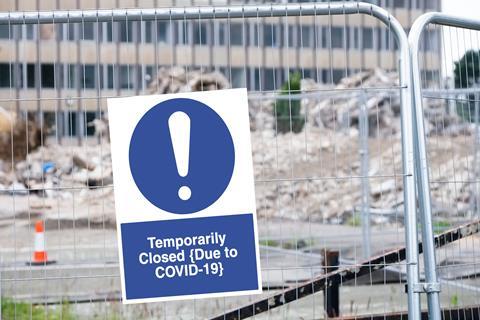First official figures show that house building work fell at fastest rate on record
Residential construction work collapsed by 60% in April during lockdown, according to official figures released this morning.

The numbers, from the Office of National Statistics (ONS), are the first official estimate of the severity of the impact on the coronavirus, and show that construction was the worst hit part of the whole economy, registering a fall of 40%.
Within construction, the figures show that new build residential construction was by far the worst affected sector by some distance. The ONS figures show that private new housing work fell by 59.2%, while public new housing work fell by even more – 66.5% - month-on-month in April.
The fall is by far the largest since monthly output figures started being compiled in 2010. Taken together with the falls in output registered in March and February, private housing output fell in April to 65% below its peak in January 2020.
The falls meant April saw £1.08bn of private housing construction work carried out, the lowest on record, and £182m of public sector construction.
The 60% month-on-month drop in residential construction compares with much smaller falls in other parts of construction, with infrastructure output dropping by 20.3%, and commercial work dropping by 39.7%.
The figures came as the ONS published its first estimate of the impact of the lockdown on GDP. It said GDP fell overall by 20% in April, with construction the worst affected of the four principle constituent parts of the economy. After construction, production was next worst hit with a drop of 20.3%, followed by services, which fell 19%. Agriculture was the least affected part of the economy, seeing a drop in output of only 5%.
Of individual industries, accommodation and food services was the single worst affected, followed by education.
Jonathan Athow, deputy national statistician for economic statistics, said: “April’s fall in GDP is the biggest the UK has ever seen, more than three times larger than last month and almost ten times larger than the steepest pre-covid-19 fall. In April the economy was around 25% smaller than in February.”
Noble Francis, economics director at the Construction Products Association (CPA) said the figures for the fall in housing work were likely to have underestimated the scale of the problem “due to issues over the sample and survivor bias”. According to Barbour ABI, nearly three-quarters of housebuilding sites shut up shop during the height of lockdown. The CPA has previously forecast that new housing starts are likely to fall by 60% this year, with output overall dropping by 42%.
Clive Docwra, managing director of consultant McBains said the figures confirmed the construction sector will face a “hugely tough time” to recover from the coronavirus pandemic. He said: “Particular concerns are private new housing work seeing a third consecutive month of large decline, exacerbated by the covid-19 lockdown on April and now at its lowest level for a decade – bad news for the industry but also for prospective homeowners given the housing shortage.”
Gareth Belsham, director of property consultancy Naismiths, said he hoped the figures would represent the “high-water mark for construction’s pain”, given sites are now reopening. However, he said: “But if April saw the moment of impact, the coming months will see the whiplash effect. Damaged business confidence and shrivelling levels of investment will continue to shake the construction industry for many months to come. The road to recovery will be long and fraught.”











No comments yet